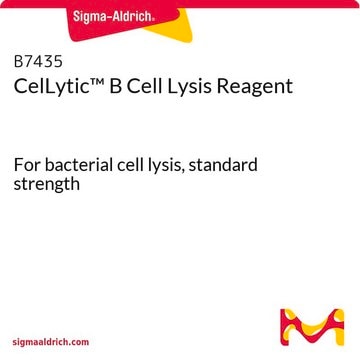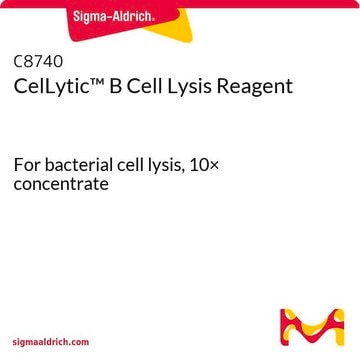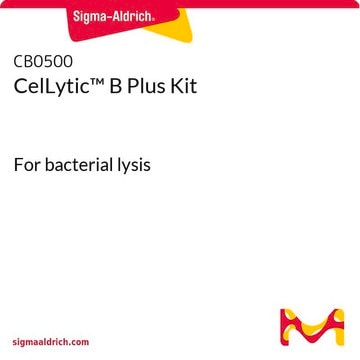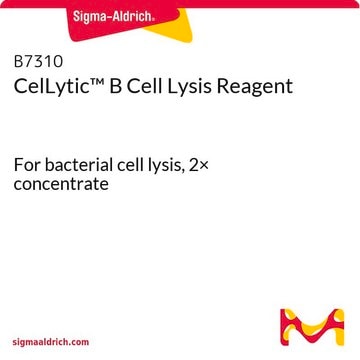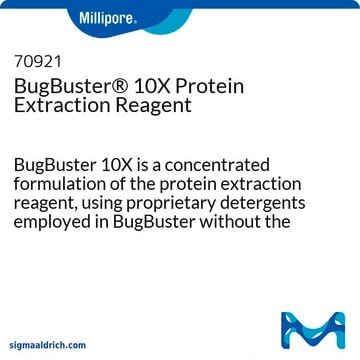The CelLytic B Lysis Reagent in this kit should not effect the nickel resin. Diluting the lysate supernatant should not be necessary, however, that depends on how much protein is being used.
CB0050
CelLytic™ B Plus Kit
For bacterial lysis
Synonyme(s) :
Cell Lysis Kit, Lysis Reagent
About This Item
Produits recommandés
Niveau de qualité
Utilisation
kit sufficient for 5 g fresh or frozen cell paste lysis.
Technique(s)
protein extraction: suitable
Conditions d'expédition
wet ice
Température de stockage
−20°C
Vous recherchez des produits similaires ? Visite Guide de comparaison des produits
Description générale
Application
Caractéristiques et avantages
- Lyse Gram positive and Gram negative bacteria
- More efficient than sonication
- Compatible with affinity purification
- Isolate inclusion bodies for subsequent solubilization
- Non-denaturing cell lysis preserves protein function
Autres remarques
Informations légales
Composants de kit également disponibles séparément
- B7435CelLytic™ B Cell Lysis Reagent, For bacterial cell lysis, standard strengthFDS
- E1014Benzonase® Nuclease, ≥250 units/μL, ≥90% (SDS-PAGE), recombinant, expressed in E. coli, buffered aqueous glycerol solutionFDS
- P8849Protease Inhibitor Cocktail, for use in purification of Histidine-tagged proteins, DMSO solutionFDS
- L3790Lysozyme from chicken egg white, 10 mg/mLFDS
Mention d'avertissement
Danger
Mentions de danger
Conseils de prudence
Classification des risques
Eye Irrit. 2 - Resp. Sens. 1 - Skin Irrit. 2
Code de la classe de stockage
10 - Combustible liquids
Point d'éclair (°F)
Not applicable
Point d'éclair (°C)
Not applicable
Faites votre choix parmi les versions les plus récentes :
Déjà en possession de ce produit ?
Retrouvez la documentation relative aux produits que vous avez récemment achetés dans la Bibliothèque de documents.
Les clients ont également consulté
-
Is CelLytic™ B Plus Kit generally compatible with commonly used nickel resins for purification of his-tagged proteins? Do I need to dilute the lysate supernatant in my binding buffer before loading it onto my preferred nickel resin?
1 answer-
Helpful?
-
-
What is the Department of Transportation shipping information for this product?
1 answer-
Transportation information can be found in Section 14 of the product's (M)SDS.To access the shipping information for this material, use the link on the product detail page for the product.
Helpful?
-
-
Can I use CelLytic B for eukaryotic cells?
1 answer-
CelLytic B was optimized for bacterial cells. It may lyse some mammalian cells. CelLytic B 10X is a better choice for the lysis of yeast and mammalian cells due to the increased detergent concentration.
Helpful?
-
-
Can I use the CelLytic™ B cell lysate in an activity assay?
1 answer-
CelLytic B contains a zwitterionic detergent so the protein is active and can be used in protein activity assays.
Helpful?
-
-
Can I concentrate my sample that was made using CelLytic B?
1 answer-
If concentrating a sample, be aware that concentration using filter concentrators may increase the detergent concentration significantly and cause issues in downstream applications. heoretically, ways to get around this are TCA precipitation, or diluting the extract below the CMC prior to concentration. This would be at least a 1/5 dilution, based on the following reference: Saito, S., and Tsuchiya, T., Characteristics of n-octyl beta-D-thioglucopyranoside, a new non-ionic detergent useful for membrane biochemistry. Biochem. J., 222(3), 829-832, 1984.
Helpful?
-
-
Can I use CelLytic B with the maltose binding protein system (MBP System)?
1 answer-
CelLytic B cannot be used with the MBP system. We have used this in the maltose binding protein system, and know that it will NOT work in this system, since any and all detergents will destroy binding of protein to the resin.
Helpful?
-
-
Can I obtain protein from inclusion bodies with CelLytic B?
1 answer-
If the protein is found in inclusion bodies, you need to use an additional reagent, Product No. C5236, CelLytic IB to solubilize the proteins from the inclusion bodies. CelLytic B is used to isolate the inclusion bodies from the bacteria. CelLytic IB, Product No. C5236 can then be used to solubilize the proteins from the inclusion bodies.
Helpful?
-
-
What is the difference between CelLytic B Plus Kits, Products CB0050 and CB0500?
1 answer-
Product No. CB0050 and CB0500 provide reagents sufficient for processing 5 g or 50 g of cell paste, respectively. Fewer grams of cell paste can be processed if proteins are to be extracted from inclusion bodies.
Helpful?
-
-
What bacterial cells can be used with CelLytic B?
1 answer-
CelLytic B Reagent by itself (no lysozyme or benzonase) was optimized for E. coli strain BL21. It also works with other common E. coli strains such as DH5?, JM109, and HB 101. The CelLytic B Reagent may be used on other similar bacterial cells. The CelLytic B Plus Kit is compatible with many more difficult to lyse Gram positive bacteria such as Bacillus and Streptococcus.
Helpful?
-
-
When using the CelLytic™ B lysis reagent, do I need to make a dilution prior to measuring protein by Bradford assay?
1 answer-
When using the CelLytic™ B lysis reagent (B7435, B7310, C8740, and contained in kits CB0050 and CB0500), it is best to use a 1:10 dilution in order to reduce the risk of interference with the Bradford Reagent. A 1:20 dilution would be even better, as long as the protein level remains within the standard curve.
Helpful?
-
Active Filters
Notre équipe de scientifiques dispose d'une expérience dans tous les secteurs de la recherche, notamment en sciences de la vie, science des matériaux, synthèse chimique, chromatographie, analyse et dans de nombreux autres domaines..
Contacter notre Service technique
